Useful Python Data Storytelling: State by State Results on 50 Years Of U.S. Education
A mapping how-to on education trends with Python Folium, Plotly, and Dash libraries
Data visualization skills are essential for the modern data scientist — and the skill to create maps is a terrific tool to have in your visualization toolbox.
In this step-by-step article, let me show you how to create interactive choropleth maps to visualize educational attainment in the United States by decade.
Keep reading with a 7-day free trial
Subscribe to Data at Depth to keep reading this post and get 7 days of free access to the full post archives.


